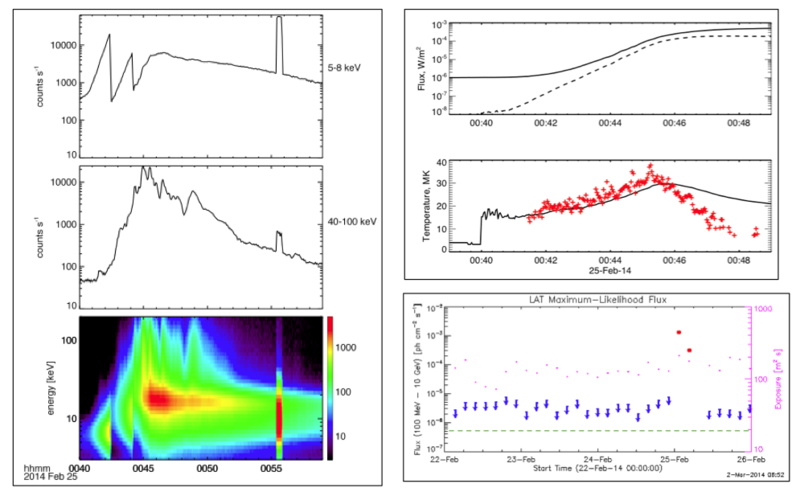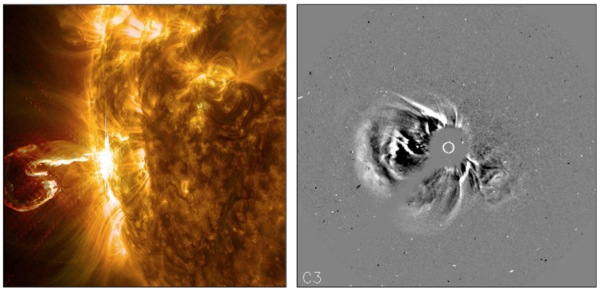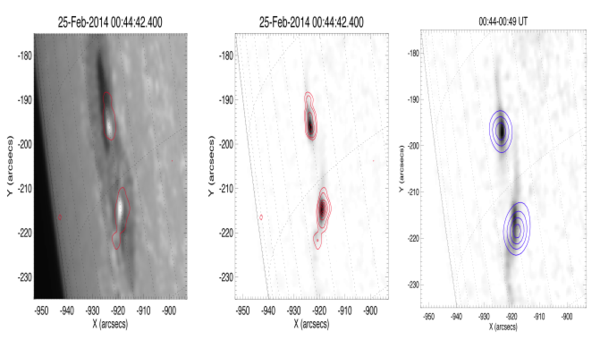A Wonderful Cycle 24 Flare
From RHESSI Wiki
(220 initial entry) |
|||
| Line 38: | Line 38: | ||
[[File:220f1p.png|800px|thumb|center|Fig. 1: | [[File:220f1p.png|800px|thumb|center|Fig. 1: | ||
Views of the high-energy processes in SOL2014-02-25: left, RHESSI; upper right, | Views of the high-energy processes in SOL2014-02-25: left, RHESSI; upper right, | ||
| - | [ | + | [http://sprg.ssl.berkeley.edu/~tohban/wiki/index.php/Instantaneous_Flare_Properties Instantaneous Flare Properties GOES]; |
| + | lower right, | ||
[https://en.wikipedia.org/wiki/Fermi_Gamma-ray_Space_Telescope Fermi LAT]. | [https://en.wikipedia.org/wiki/Fermi_Gamma-ray_Space_Telescope Fermi LAT]. | ||
]] | ]] | ||
| Line 49: | Line 50: | ||
Second (upper right) the GOES soft X-rays during the rapid impulsive | Second (upper right) the GOES soft X-rays during the rapid impulsive | ||
increase; the red temperature points show the incremental approach | increase; the red temperature points show the incremental approach | ||
| - | introduced in | + | introduced in a |
| + | [http://sprg.ssl.berkeley.edu/~tohban/wiki/index.php/Instantaneous_Flare_Properties previous Nugget]. | ||
This entire development took only ten minutes. | This entire development took only ten minutes. | ||
Finally, the lower right showing the remarkable >100 MeV counts from the | Finally, the lower right showing the remarkable >100 MeV counts from the | ||
| Line 61: | Line 63: | ||
it to Earth. | it to Earth. | ||
| - | [[File:220f2a.png| | + | [[File:220f2a.png|600px|thumb|center|Fig. 2: |
Views of the event in the EUV (left; see the | Views of the event in the EUV (left; see the | ||
[http://sdo.gsfc.nasa.gov/assets/gallery/movies/X4_flare_combo_best.mp4 movie] | [http://sdo.gsfc.nasa.gov/assets/gallery/movies/X4_flare_combo_best.mp4 movie] | ||
| Line 69: | Line 71: | ||
Note that 100-MeV gamma rays were still coming from the Sun (the white circle) as this ejection sped | Note that 100-MeV gamma rays were still coming from the Sun (the white circle) as this ejection sped | ||
past the coronagraph's field of view. | past the coronagraph's field of view. | ||
| + | ]] | ||
| + | |||
| + | == The White-Light Flare == | ||
| + | |||
| + | We know that the most powerful part of a solar flare appears in the lower atmosphere, where the | ||
| + | "white-light flare" phenomenon had been discovered in 1859 by | ||
| + | [https://en.wikipedia.org/wiki/Richard_Christopher_Carrington Carrington] and | ||
| + | [http://adsabs.harvard.edu/abs/1859MNRAS..20...15H Hodgson] independently. | ||
| + | This flare produced intense white-light emission, concentrated into two major bright regions | ||
| + | as was the case for the 1859 flare. | ||
| + | Figure 3 compares these brightenings with hard X-ray and soft gamma-ray observations from | ||
| + | RHESSI. | ||
| + | |||
| + | [[File:220f2.png|600px|thumb|center|Fig. 2: | ||
| + | Left, the white-light flare emission seen without differencing, each patch in a sunspot | ||
| + | penumbra; middle, the overlay with RHESSI hard X-rays at >30 keV; right, the overlay at >250 keV. | ||
| + | Both of these comparisons confirm the intimate association of the powerful white-light flaring, | ||
| + | and particle acceleration up into the gamma-ray domain. | ||
]] | ]] | ||
[[category: nugget]] | [[category: nugget]] | ||
Revision as of 16:54, 2 March 2014
| Nugget | |
|---|---|
| Number: | 218 |
| 1st Author: | S$auml;m Krucker |
| 2nd Author: | Mitsuo Oka |
| Published: | March 3, 2014 |
| Next Nugget: | TBD |
| Previous Nugget: | Instantaneous Flare Properties |
| List all | |
Introduction
Somewhat surprisingly, even this ostensibly weak Cycle 24 has produced 29 X-class flares thus far. Of these the third most powerful, GOES X4.9, just happened a week ago (25 February 2014). Reflecting the weakness of the solar cycle, the active region responsible (NOAA Region11990) had a relatively small sunspot area, only 250 millionths of the solar hemisphere - the biggest groups can be an order of magnitude larger.. But the flare itself was magnificent, and this Nugget just points to early views from RHESSI and other observatories.
The Flare
A RHESSI-centric overview of SOL2014-02-25 can be seen in its specifically tailored Browser page; note that the quick-look images have incorrect roll information, not an important problem but reminiscent of the antipodal flare theory proposed in a Nugget last April 1. Figure 1 shows the spectrogram representation of the RHESSI Data, showing many impulsive peaks and hinting at a soft-hard-harder component.

The high-energy views in Figure 1 show several things. First, the standard spectrogram representation for RHESSI, showing many hard spikes and other systematic behavior. This can be localized to the image position thanks to RHESSI's capabiity for imaging spectroscopy. Second (upper right) the GOES soft X-rays during the rapid impulsive increase; the red temperature points show the incremental approach introduced in a previous Nugget. This entire development took only ten minutes. Finally, the lower right showing the remarkable >100 MeV counts from the Fermi LAT instrument; here the high-energy radiations persisted for at least two three-hour increments.
Glimpses of the flare in EUV and coronal images are in Figure 2, with links to their movie versions. A flare of this magnitude almost always produces powerful coronal effects, and this was no exception; in spite of its E limb location, its high-energy particles readily made it to Earth.

The White-Light Flare
We know that the most powerful part of a solar flare appears in the lower atmosphere, where the "white-light flare" phenomenon had been discovered in 1859 by Carrington and Hodgson independently. This flare produced intense white-light emission, concentrated into two major bright regions as was the case for the 1859 flare. Figure 3 compares these brightenings with hard X-ray and soft gamma-ray observations from RHESSI.

| RHESSI Nugget Date | 3 March 2014 + |
| RHESSI Nugget First Author | S$auml;m Krucker + |
| RHESSI Nugget Index | 218 + |
| RHESSI Nugget Second Author | Mitsuo Oka + |